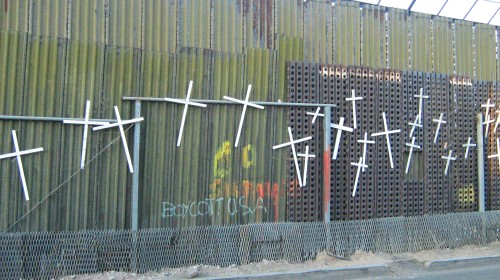**This is my first post with photos. As you can see, I am slowly but surely incorporating technology into the blog :)**
Normally, when I have to meet my Mexican coworkers near the border, I walk right into Mexico through the turnstile doors. Sometimes there is a guard, more times there isn’t.

Even though Nogales is a more tranquilo border city than the ones in the news (Tijuana, Juarez), I don’t usually linger too long near the line because as a guera (light-haired, light-skinned), I’m recognized as an American (which I am mostly), assumed to have money (which I don’t really), and solicited for a taxi, taxi or to buy pharmaceuticals or souvenirs “for your boyfriend”, as I’m told in impressively unaccented English. This interaction, sort of amusing and novel the first time I crossed 5 months ago, lost its appeal pretty quickly and I’ve trained hard to maintain an as-uninterested-as-possible expression on my face to reduce the rate of solicitations to buy stuff. It’s sort of worked. It also helps that I’m chaparrita (short) so I blend in more if I travel alone.
A few days ago I had the chance to linger for a longer while and observe the pedestrian traffic on the Mexican side. I wasn’t exactly surprised by what I saw, since I have been a foot pedestrian for a while now, but standing there and doing nothing but watching, I became newly aware of the contrasts and different degrees of privilege before me, all coexisting for brief moments as they pass and don’t pass each other. These are the people that I share foot space with on the Nogales border:
- The most privileged crossers: American-passport carrying retirees venturing into Mexico on an excursion to try burros (burritos), buy cheap medicine among the sea of pharmacies and perhaps a mask or some animal horns (no joke, I saw retirees carrying this as a souvenir a few weeks ago).
- The second most privileged crossers: Mexican-Americans with US passports, mostly residents of the border on the US side, going to visit their families, work, conduct business, and carry out the million other activities that link the two sides. I think of this group as the second most privileged because they tend to have less disposable income than the retirees and are often treated rudely by Customs officials for being Mexican.
- The semi-privileged crossers: A little known but large group totaling several million border residents who after proving their ties to Mexico (through business, employment, family, property, or other ties), i.e. that they are only entering the US for a temporary stay, applied successfully for border crossing cards that entitle them to enter the US, 25 miles inland, and up to Tucson 65 miles away in Arizona, for a period of 30 days. This group, a huge chunk of border traffic, is semi-privileged because they have to jump through a lot of hoops to cross legally, and even when they do their movement in the US is limited.
- The non-crossers: The majority of Mexicans do not qualify or cannot afford visas to the US and cannot cross through legal means. (Mexicans who hail from areas south of the border do not qualify for the border crossing cards.) Those who want/need to cross but can’t are forced to cross illegally. When I lingered, I watched about 25 crossers in camouflage dark green, blue and black clothing. It wasn’t clear to me which of them were preparing to cross and which had just been deported. Some carried Homeland-Security issued plastic bags with clothes in them. I’m not sure whose clothes they were. Although I was intensely curious, I respected their privacy and held back from asking questions since they were either about to embark on a possibly deadly journey or had been forcibly returned from one.
I feel like it’s so obvious, but I still need to point out how incredibly unfair it is that people like me can cross on a whim, that the hierarchy of border crossers exists and that the “non-crossers” have to risk their lives to cross. On a return visit to the border on Friday, I snapped these two shots. The first is a small section of the wall in which Nogalenses have attached crosses to mourn the Mexicans who have died crossing. You can’t see it in the picture but the crosses bear the names of the dead.

And this is the graffitied sentiment on the wall generated by unequal border policies and the resulting deaths.

For those who don’t know Spanish, the graffiti reads, “BORDERS, SCARS ON THE LAND.”
In an ideal world, I would advocate for the erasure of borders. In the real world, I want to push for a sensitization of borders to people’s needs and wants, to be with family, to work, to travel, to move more freely.
The border crossing card that allows the semi-privileged crossers entry into the US may be the model that we need to build off of. This card could possibly increase Mexicans’ and other foreigners’ access to the US and create reciprocity between US immigration policies and the freer immigration policies of countries that allow us unlimited entry. Obviously the border visa card would need to be revised – 25 miles and 30-day restrictions just don’t cut it – but it is a start. The border visa card could even win over conservative Americans. Its laser technology means authorities can regulate who is entering, and because it allows people to come and go, it is likely to reduce “illegal” immigration. This is by far not the only solution, but one that seems fairly obvious for this border resident.


I applaud your recognition of your privilege to easily cross the border while others risk a death march through the Sonora Desert.
Thank you for sharing.